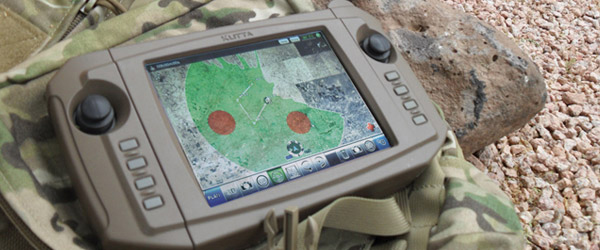A small Phoenix-based company is using federal grants to develop technology that will allow U.S. Army soldiers to control UAS for resupply missions, surveillance and zeroing in on targets. Handheld controllers will use Kutta Technologies Inc.’s software so frontline troops can control UAS in a way similar to video gaming.
Instead of sending convoys out to resupply troops and exposing them to improvised explosive devices, the idea is that soldiers can load the unmanned helicopters and send them without a pilot into environments such as the mountains of Afghanistan and Iraq. They would drop what the military refers to as the necessities: “blood, bullets and beans,” said Doug Limbaugh, Kutta CEO.
“They use our controller to bring that unmanned resupply ship in, land it, get the supplies off and send it back home,” he said. The technology will be demonstrated in September, and the Army plans to put it in the field in fall 2012, said Lt. Col. Jennifer Jensen, Army product manager for common-systems integration for unmanned-aircraft systems.
Continuous software upgrades over the past several years now mean unmanned aircraft can be equipped with as many as three sensor balls, or cameras, to autonomously acquire targets. The technology can be used for more than resupply missions. For example, the remote video terminals can be mounted in vehicles, stationed in a tactical-operations centre or put on an aircraft, Jensen said.
“There are multiple places and locations we put this system,” she said. “They (soldiers) could be on the move and have the aircraft watch themselves, or maybe they see something and they want to steer it to go check out what is going on – a riot or whatever someplace. It’s not limited to any type of operation.”
Kutta offers a range of products, but it created a niche in unmanned aircraft. It developed its unmanned technology as well as other products with help from Small Business Innovation Research grants and commercial sales of about $18 million.
“A lot of things are shrinking in the Department of Defense budgets, but the budgets for UAS and UAS technology is growing,” Limbaugh said. “We’re right in the middle of it. We’re kind of a little guy, but we’re making a big splash in the UAS industry right now.” Army deployments of unmanned-aircraft systems have increased dramatically – with 47 times more deployments now than in fiscal 2003, the Army says.
Kutta was founded in 2001 as an aviation system and software company, but that division was sold about four years ago, Limbaugh said. In 2003, the company won a $5,000 Arizona Fast Grant through a Department of Commerce programme that assists Arizona technology companies with commercialization efforts, especially in obtaining federal SBIR grants.
When Kutta later was awarded $70,000, it developed UAS software that ran on personal digital assistants, also known as palmtop computers. Since then, the company developed about 10 other products for which it received SBIR grants. Kutta employs about 30, including contractors. “One of the nice things about SBIRs is they really do allow you to develop some cutting-edge technology,” Limbaugh said, adding that he recently testified before Congress on the success of the programme.
Software for Kutta’s PDA product was upgraded and is expected to be installed in 3,000 terminals used by the Army in the next three years. Before Kutta’s technology, soldiers only could view the video streaming from an unmanned aircraft. Now, with minimal training, they will be able to survey routes, instruct the drone to follow them and track moving targets. “He just points and clicks,” Limbaugh said, adding that soldiers in the field will be able to guide the drones using laptop computers.
The September test will show whether Kutta’s technology will take control of several Army UAS, including the Shadow, the Gray Eagle – which is the Army’s version of the Predator – the Hunter, the Raven and the Puma. Eventually, the company hopes its software will move control of drones from soldiers on the ground to pilots of Army helicopters, including the Apache. From the cockpit, pilots could use unmanned vehicles to spot and attack targets from longer distances.
Source: The Arizona Republic

